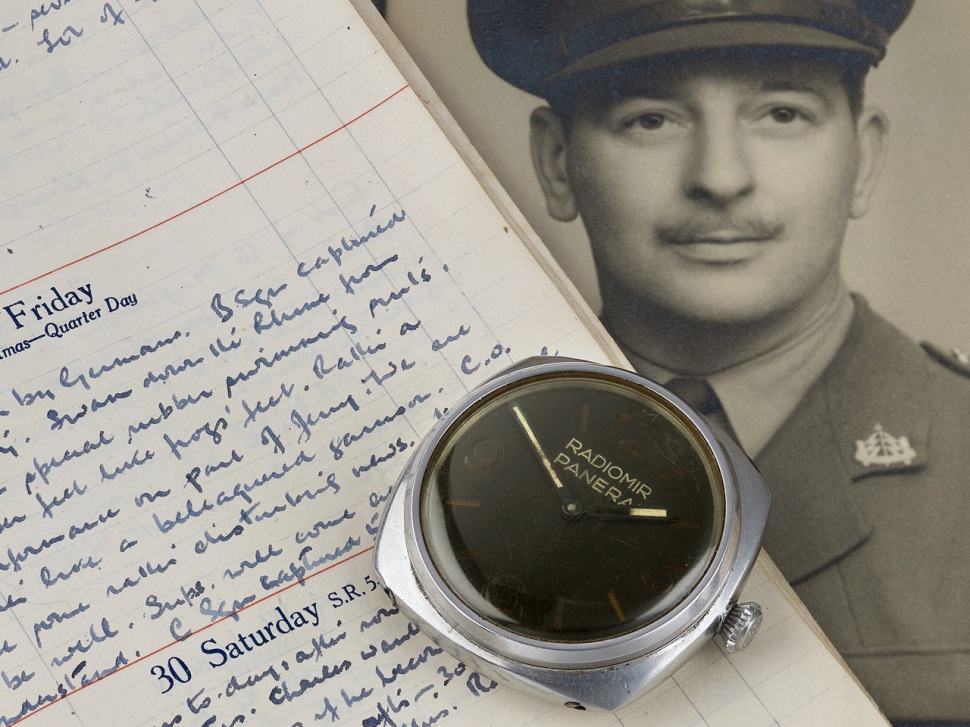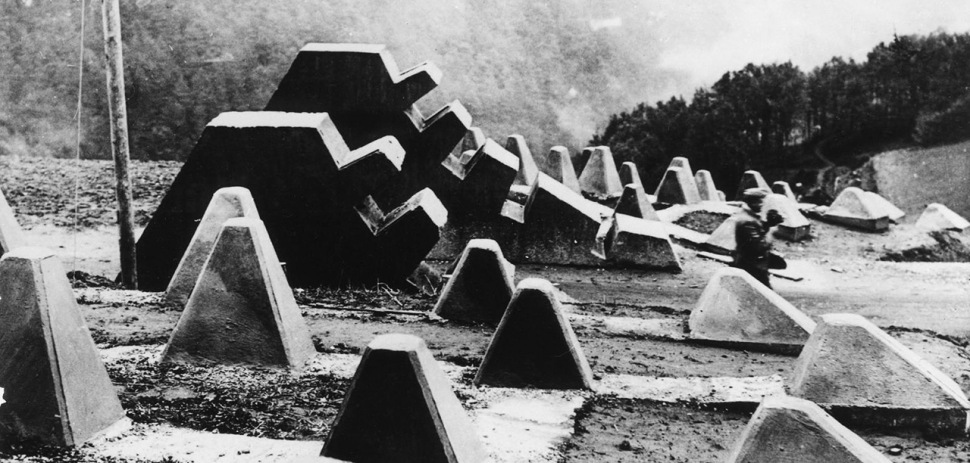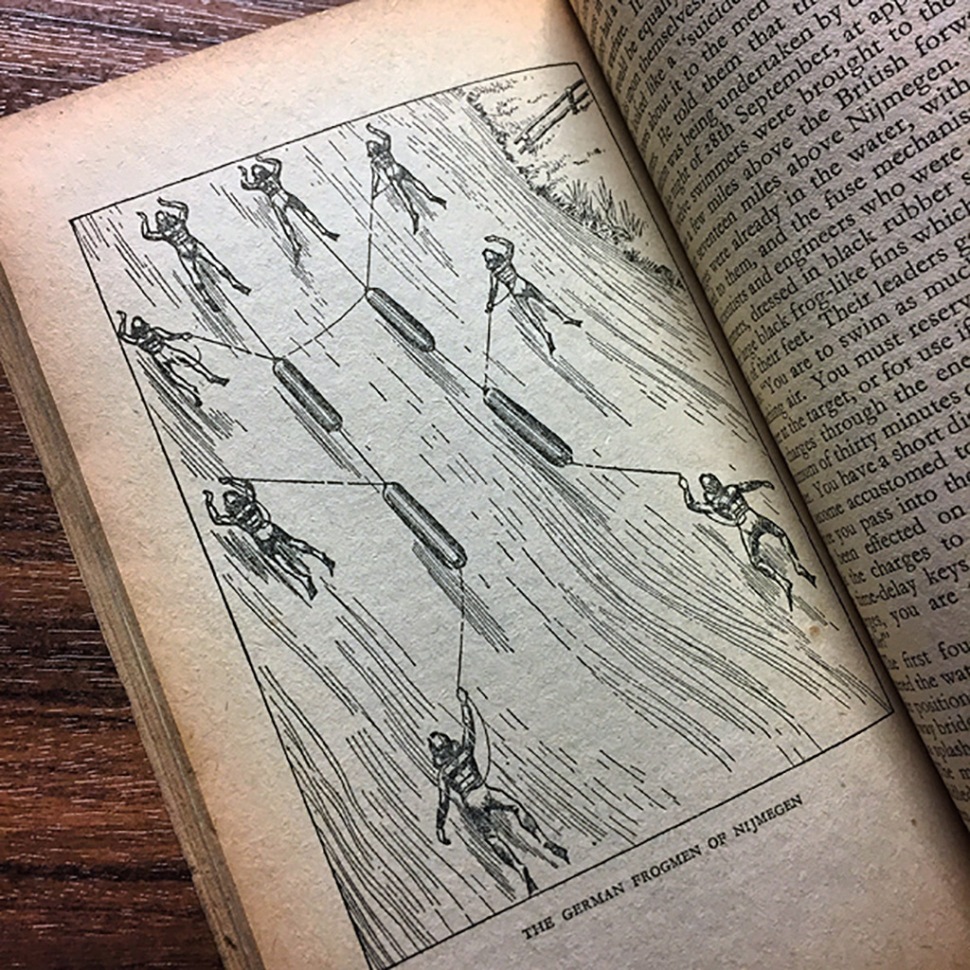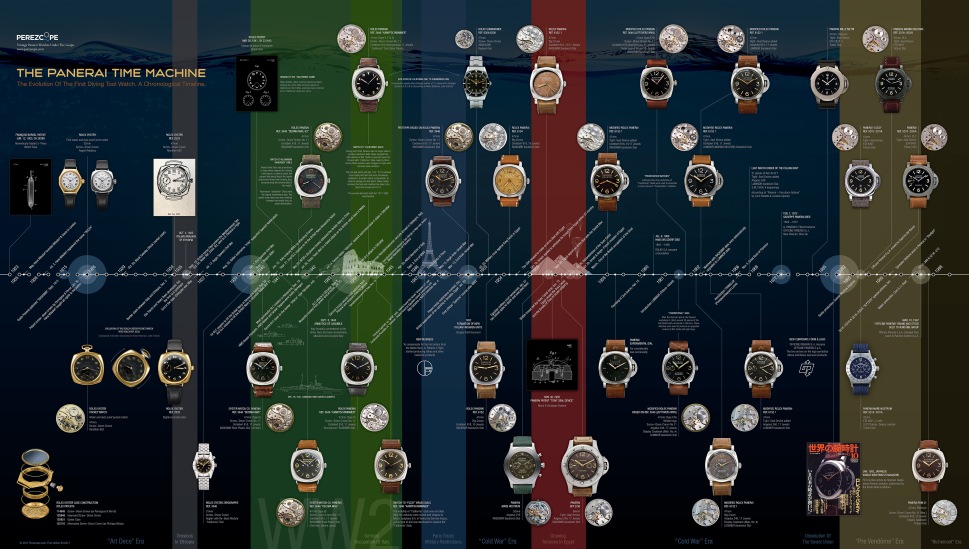About a year ago in January 2018, the long established British auction house Fellows auctioned a historically important vintage Panerai that was related to the famous German Kampfschwimmer attacks on the bridges of Nijmegen in the Netherlands. Watches of this magnitude don’t come up often. It is therefore all the more impressive that Fellows managed to get their hands on a second Panerai related to those attacks that is completely new to the market.
The new watch was consigned by the son of Major Packer, a British reconnaissance officer whos unit arrested a group of Kampfschwimmers on the banks of the Waal river.
The watch comes with a big deal of historical documents and even Packer’s field uniform. What it does not come with though are the wire lugs, as they went missing at some point. This could be the perfect restoration project for a daring watch collector.
.
LOT 159 – Rolex Panerai Ref. 3646
Reference: Rolex Panerai 3646
Dial: Aluminium Sandwich Dial (first generation)
Case number: 1010049 (Type B)
Estimate: GBP 20,000 – 30,000
Price realized: GBP 53,592.00 (incl. premium)
 .
.
Auction link: LOT 159 – PANERAI – a very rare and special stainless steel Second World War military Diver watch head
.
A watch with missing wire lugs? Yes, but don’t be discouraged as missing wire lugs is a known problem among early 3646s and something that – with the right contacts – can easily be dealt with.
Ref. 3646 from 1940 was based on the very first Oyster watches from 1926. The soldered wire lugs were a known weakness of this case construction. In 1932, Rolex therefore introduced a completely new Oyster case (Rolex Bubbleback) with solid lugs that were carved out of the same block of metal as the case.
It is safe to say that by the time Ref. 3646 was introduced in April 1940, this type of case construction, which goes back to François Borgel’s 3-piece case from 1903, was more than outdated. The claim that Ref. 3646 was the best available technology at the time of its release is best suited in the realm of marketing fantasy.
.
Dial & Hands
Panerai Sandwich dials with this sort of diabolic dark red patina are extremely sought after in vintage Panerai collector circles. Unlike later dial batches, the first generation of Panerai’s world famous aluminium Sandwich dials developed a mysterious dark patina that makes the numerals and markers appear almost non existent.
The Radiomir Panerai engravings on this dial are exactly the way they should be, with the last R of Radiomir slightly being shorter than the R in Panerai. This is a great example of a first generation aluminium Sandwich dial.
Panerai developed the aluminium Sandwich dials to overcome the issues experienced with Panerai’s very first dials which consisted mainly of plastic layers and warped to an extend where the watches became useless.
Both skeletonized hands are heat blued. This technique was used to prevent the hands from oxidizing. The hour hand is missing the lume in its inner compartment. It is unknown whether the lume is still the original or if the hands were relumed at some point.
.
Case & Crown
As mentioned earlier, the wire lugs of this watches are missing. At first glance this may look like a total loss but soldering a new pair wire lugs is easier than you think. If you happen to be to the lucky winner of this lot, just let me know and I will put you in touch with people who have done this before.
The middle case itself appears to be in a good condition with clear signs of wear. Remember, this watch was involved in one of the most daring enterprises of WW2.
The original Rolex screw-down crown No. 11 is in good shape too for its age. Brevet is french for patent and the cross refers to the iconic Swiss Cross.
A watch of this caliber deserves the best possible strap, once the wire lugs are done. A good place to start looking is one of my favourite strap makers, Panerai strap Professor Kostas Venizelos aka Kostas Straps. Kostas has studied vintage Panerai straps in all details. The following Kostas strap was made with original 1940s leather and would be a perfect fit for the watch.
 .
.
Movement & Caseback
The movement of this watch matches the case number perfectly. This is an elaborated Rolex 618 Type 1a with 17 jewels made by Cortebert. Typical for these calibers is the overcoiled Breguet hair spring and the fully jewelled escapement wheel featuring cap stones on both sides.
As it should be for this type of movement, the Rolex engravings on the train gear bridge follow the upper curve of the bridge. The overall condition is simply stunning for an age of almost 80 years.
The brass-coloured movement retaining ring is another perfect match. As you can see, the brass ring has developed some oxidation.
The inside of the caseback bears typical Oyster Watch Co(mpany) hallmarks from 1941. The Oyster Watch Company was a sub brand of Rolex.
The whole inner surface is adorned with so-called “perlage” finish (circles). In certain angles, the perlage finish has a 3D effect and looks almost like fish scales.
The 7-digit case number 1010049 is a Rolex pocket watch case number. Oyster case numbers from 1941 had 6 digits. For some reason, the first 3 batches of Ref. 3646 (Type A, B & C) were produced within the Rolex pocket watch line.
The first two batches of Ref. 3646 (Type A & B) were produced under the Oyster Watch Co label.
Most Rolex Oyster watches produced between 1932 and 1938 carry the Oyster Watch Co stamp on the inside of the caseback.
It appears that Rolex abandoned the sub brand Oyster Watch Co around 1941/42. The third batch of Ref. 3646 (Type C) from 1942 bears the usual Rolex engravings used between 1938 and 1945.
The next picture shows where this watch gets even more interesting. The outside of the caseback bears the engravings “Kurt Kohlrusch”. I am not aware of any other “Kampfschwimmer” watch that was personalized like this during the war.
The question is, who engraved the caseback? Was it done by Kohlrusch himself prior to the mission or was it done by Major Alfred Packer to commemorate Kohlrusch?
There is almost no information about Kurt Kohlrusch. A total of 12 Kampfschwimmers attacked the bridges in the early morning hours of Sept. 29, 1944. They formed two groups. A 4 men group was appointed to the railway bridge while the other team consisting of 8 men focussed on the more important road bridge.
Kohlrusch is listed in a secret interrogation report on German prisoners of war, recorded between Oct. 21 and Nov. 18 1944. The report can be accessed under the following link.
Link: MK (MEERESKAMPFER) 700, (Swimming Saboteurs), KdK
.“C.S.D.I.C. (U.K.)
S.I.R. 1124THIS REPORT IS SECRET
Consolidated report on information obtained from the following Prisoners of War:-
(A) – CS/536 Matr. Gefr. DYCK
(B ) – CS/532 Matr. Gefr. GEBEL
(C) – CS/533 Matr. Gefr. HAWELKA
(D) – CS/537 Steuermannsmaat KOLRUSCH
(E) – CS/538 Mech Maat OHRDORF
(F) – CS/534 Matr O/Gefr OLLE
(G) – CS/539 Matr O/Maat ORLOWSKI
(H) – CS/535 Fw SCHMIDT
(I) – CS/531 Matr Maat WEBER
(J) – CS/530 Matr O/Gefr WOLSCHENDORFMK 700 (Swimming Saboteurs),
captured nr OCHTEN, HOLLAND,
29 September 1944″.
History of the watch
Operation Market Garden
After the successfull Allied landings in the Normandy in June 1944 and the chaotic retreat of German forces in August 1944, the Allies swiftly captured the whole of Northern France and Belgium. Allied strategists saw a chance to end the Nazi nightmare by Christmas 1944.
To achieve a strategic surprise by launching a lightning thrust into the Ruhr, the very heart of Germany’s war industry, Field Marshal Sir Bernard Montgomery of the British Army conceived one of the most ambitious Allied plans of WW2: Operation Market Garden.
.
The plan forsaw the intact capturing of a series of important bridges over several canals and rivers in occupied Holland in order to completely circumvent the heavily fortified “Siegfried Line” (Westwall) before sweeping east into Germany itself.
The “Westwall” was Germany’s defensive line at the west border of the Reich. Built in the 1930s, it consisted of around 15,000 bunkers, countless tunnels and tank traps as far as the eye could reach.
Operation Market Garden was the biggest combined air and ground offensive ever seen in the history of warfare. Over 40,000 paratroopers were deployed to capture and hold the vital bridges while Allied ground forces were fighting their way up north to come in support of the airborne divisions.
Under heavy losses, the American 82nd Airborne Divison secured the bridges in Grave and Nijmegen. The American struggle in Nijmegen became famous as “Little Omaha” in reference to the heavy casualties suffered during the Normandy landings.
The most vital bridge in Operation Market Garden, the bridge over the Rhine river at Arnhem, proved to be one bridge too far. The 1st British Airborne Corps failed to secure the structure due to unexpected strong German resistance supported by SS Panzer Divisions. In addition, the Allied ground forces advanced way too slow. After nine days of resistance, what had been left of the beleaguered 1st British Airborne Division, was evacuated. By then, the moment of surprise was gone. Operation Market Garden failed.
.
Bridges of Nijmegen
Despite the defeat at Arnhem, the Allies were able to hold the bridges of Nijmegen. The following aerial view shows the railway bridge to the left and the road bridge to the right. The flow direction of the Waal River is from right to left.
After the bridges were captured by the American 82nd Airborne Divison in Operation Market Garden, the Germans decided to destroy the structures. A first reconnaissance mission carried out with explosive boats failed miserably. Destroying the bridges from the air was risky due to the supremacy of the Royal Air Force.
At this stage of the war, the road bridge (front) was more critical than the railway bridge as it allowed a free flow of tanks and supplies dangerously close to the German border.
During the night of Sept. 28, the Germans sent in their secret weapon, the Kampfschwimmers.
Two groups of Kampfschwimmers, one with 4 men and the other with 8, entered the freezing cold Rhine River around 10 kilometres upstream from Nijmegen. To cause a maximum of damage to the targets, the Kampfschwimmers were equipped with floating charges weighing 600 kg each. The charges had the shape of torpedoes and were connected to each other with a long rope to enable them to wrap around the pillars.
.
Railway Bridge
The railway bridge had already played a strategically important role during the early days of WW2.
In an attempt to slow down the Nazi invasion (Blitzkrieg) of the Netherlands, the Dutch military destroyed the middle section of the bridge on Mai 10, 1940.
Since the bridge was of crucial importance for Nazi war efforts, the structure was swiftly repaired. The first train was able to cross on Nov. 17, 1940. Two new pillars were added and the middle section arch became considerably smaller. The following photo shows the repaired railway bridge.
The first Kampfschwimmer team consisting of Bretschneider, Jäger, Olle and Wolchendorf was appointed to the railway bridge. The four men had two floating charges at their disposal.
The following German drawing from Nov. 1944 illustrates how the charges were carefully placed around the pillar of the railway bridge. Keep in mind that this operation was carried out in a freezing cold river with a strong current.
Once securly placed, the charges were flooded and submerged to the bottom of the pillar. Then, using their oxygen mask, the Kampfschwimmers followed their charges down and activated the timer mechanisms.
The following explosion destroyed the pillar and brought down the middle section of the bridge.
The bridge could no longer be used by the Allies. The four men drifted downstream into German occupied territory.
Olle and Wolchendorf were soon discovered and captured by the Allies, as the bridgehead had already been extended. Bretschneider and Jäger managed to reach the German lines and were awarded the German Cross in Gold.
.
Road Bridge
At the start of the Second World War, the Dutch military also tried to destroy the road bridge. The damage caused was only minor and the Germans restored the bridge by 1943.
During the night of Sept. 28 1944, the second Kampfschwimmer team was assigned to the road bridge, which, at this stage of the war, was a more important target than the railway bridge. According to Waldron & Gleeson’s book “The Frogmen”, this group carried four floating charges. The following illustration from “The Frogmen” shows how the unwieldy charges were towed.
Kurt Kohlrusch, the original owner of the watch in question, was part of this group. Owing to the strong river current, the Kampfschwimmers had a hard time placing the charges around the road bridge pillar. To make matters worse, the frogmen were discovered by Allied sentinels and immediately put under heavy fire.
The charges were hastily flooded and activated. Due to the inacurate placement, the subsequent explosion did not have much effect on the pillar itself. Only parts of the superstructure were damaged.
The picture below shows the road bridge after the damaged section was stabilized with two bailey bridges by the Allies.
The next picture shows the two bailey bridges in detail.
Totally exhausted, the Kampfschwimmers reached the river bank near Ochten, where they were captured by the Allies.
The following drawing published in The Illustrated London from Oct. 1944 illustrates the very moment some of the Kampfschwimmers were captured. Major Packer, the British officer who took the watch from Kohlrusch, was part of the British reconnaissance unit depicted in this sketch.
Frogmen were a spectacular sight in 1944, no question. This type of underwater warrior, with skin-tight rubber suit and never-before seen swimfins was invented by the Italian GAMMA commander Eugenio Wolk in late 1941. The German Kampfschwimmers trained alongside the Italian frogmen (Gruppo Gamma) in German-occupied Italy and were supplied with the very same equipment as the Italians.
The British soldiers who captured the German Kampfschwimmers near Nijmegen must have been completely blown away by the fantastic appearance of the Kampfschwimmers.
Accordingly, the text of the above article reads:
“Like men from Mars! Amphibious German assault troops captured near Nijmegen, presententing a fantastic appearance in skin-tight rubber suits, extraordinary rubber flappers, rubber skull-caps and oxygen masks. The whole denoted a daring night attempt to blow up the Nijmegen bridges, the men being detected struggling upstream in the early morning.”
.
Interestingly, the article reads further:
“The first charge exploded by the road bridge, doing little damage, the second was heroically rendered harmless by a naval lieutenant who dived under the bridge.”
.
As you can see, the article published in The Illustrated London does not mention the destruction of the railway bridge at all. Instead it claims the charges were neutralized by a naval lieutenant who dived under the bridge. This could be part of war related disinformation.
There are several contradicting reports as to what exactly happened that day. Some sources say two Kampfschwimmers were shot and died. A third one was injured and perished later as a result of his injuries. The above mentioned interrogation report listed 10 prisoners of war taken during the assault on the bridges of Nijmegen. It appears that only Olle, Wolchendorf and Ohrdorf refused to cooperate with the Allies. All other Kampfschwimmers gave vital information about the Kampfschwimmer unit to the Allies.
Kurt Kohlrusch (Prisoner of War D) is mentioned in at least two paragraphs in the above mentioned interrogation report.
“Prisoners of War A and D state that the unit was visited in the early spring by a German Admiral for whom both the German and Italian swimmers were paraded. On this occasion the Admiral addressed himself only to the Italian contingent. According to Prisoner of War G the unit was also visited by Major Graf THUN v HOHENSTEIN.”
“Prisoner of War A dn Prisoner of War D state that the LW FPN was later changed to M24??? (or 24678) and eventually replaced, after the move to ST GIORGIO by FPN M 10907.”
.
The present watch was consigned by Major Packer’s son. Major Packer was an officer of the 43rd Reconnaissance Regiment which played a major role in the ground part of Operation Market Garden. The portait below shows Packer wearing an uniform with typical Reconnaissance Corps insignia (arrow & bolts).
Packer mentioned the capturing of a total of 10 Kampfschwimmers in his diary, an important historical document that is included as part of the set.
On Sept. 29, 1944, the diary reads:
“Bridges blown by Germans. B Sqn captured 5 of the party. Swam down the Rhine from Germany in special rubber swimming suits with rubber feet like frog’s feet. Rather a clever performance on part of Jerry. We are now rather like a beleaguered garrison. C.O. told me some rather disturbing news. Hope all will be well. Sup[plie]s will come across in DUKS I understand. C Sqn captured 5 more of the “dynamiters”.”
.
Several other documents are also part of the set.
Also included in the set is Alfred Packer’s field uniform. The crown on the shoulder pad is the symbol for the Major rank. According to his service book, Packer was still a Captain during the events at Nijmegen. After the cease fire, he was promoted to Major, as stated on the front page of his “Officers’ Release Book”, and served in occupied Germany until he was discharged from the Army in April 1946.
The dragon on black background was the insignia of the 43rd Reconnaissaince Regiment.
Packer returned home to his old job as a Commercial Traveller for a biscuit manufacturer afterwards.
.
Thoughts
Kohlrusch’s/Packer’s watch is another historically significant piece of the Panerai puzzle. German frogmen appointed to daring missions like the one executed in Nijmegen were well trained professionals of the first hour. This is also reflected in the watches these men were wearing. All timepieces related to the attacks of Nijmegen bear Radiomir Panerai engravings on the dial and belong to the very first batch of watches confiscated by the Germans in the first months of 1944.
The following picture shows a German Kampfschwimmer in Venice wearing a 3646. The Radiomir Panerai inscription is clearly visible.
Early Kampfschwimmer watches proudly bear the Radiomir Panerai inscriptions since they were originally meant for the Italian Decima MAS. According to Sergio Nesi, ex Decima MAS member and book author, these watches were paid for by the Decima MAS but then confiscated by the Germans.
“2) La X Flottiglia aveva ordinato e pagato degli orologi da sommozzatore in costruzione presso la ditta Panerai di Firenze. Per facilitare il ritiro era stato incaricato il tenente di vascello Schomburg che, recatosi a Firenze, aveva ritirato gli orologi e li aveva incamerati per la Marina Tedesca, sottraendoli cosi a quella italiana.”
Translation: 2) The X Flottiglia had ordered and paid a number of diver watches from the Panerai company in Florence. Since Lieutenant Commander Schomburg was in Florence at the time, he was asked to take delivery of the watches. He confiscated all of them for the German Navy and left the Italians empty-handed.
.
Typical Kampfschwimmer watches have anonymous dials. These watches belong to a later batch and were produced on specific request by the German forces during the occupation of Italy. Giuseppe Panerai refrained from putting his name on them for a number reasons, one of them being not wanting to be associated with the Nazis. In talks with Maria Teresa Panerai, the widow of Giuseppe Panerai, I learned the Nazis never paid for a single watch.
Anonymous Panerai watches were anonymous for a simple reason: The Nazi nightmare! Neither Panerai nor Rolex wanted to have their names on these watches. Rolex kept the supply flowing solely to protect the Panerai family in occupied Florence. Claims that the watches were left unmarked to keep the nationality of the divers secret are total nonsense. All divers had to carry an ID in case of getting captured, else they could have been executed as spies on the spot according to martial law.
Kohlrusch’s 3646, still proudly bearing the Radiomir Panerai engravings, is how the first Panerai watches were meant to be. It may have lost its wire lugs but it has not lost any of its charm. This watch is an amazing piece of history, well worth to be restored to original condition.
Read more: Historically Important Vintage Panerai 3646 at Fellows
Thank you for your interest.
.
The Panerai Time Machine
Rolex-made Panerai watches of Ref. 3646 with first generation sandwich dials are an important milestone in Panerai’s history. These watches were literally shaped by historical events. The infographic below shows all vintage Panerai watches in their historical context. Please click the graphic to download the highres version.
This timeline is available as a high quality print in two sizes:
- 120 x 68 cm (47 x 26 inch): EUR 85.00 (plus shipping)
- 150 x 85 cm (59 x 33 inch): EUR 120.00 (plus shipping)
Printed with HD Inkjet on heavy synthetic paper and laminated.
Limited edition: 50 pieces, numbered and signed by Maria Teresa Panerai in Giuseppe Panerai’s very own laboratory at the historical site of the Villino Panerai (Panerai Villa) in Florence: Sold out
More information: The history of Panerai watches at a glance


































Great job finding Waldron & James’ “The Frogmen” account of this mission. A rare find. You guys are legit! Keep up the great work!
LikeLike
I have some information for you. Please contact me.
LikeLike
Done, please check your mailbox and spam folder.
LikeLike